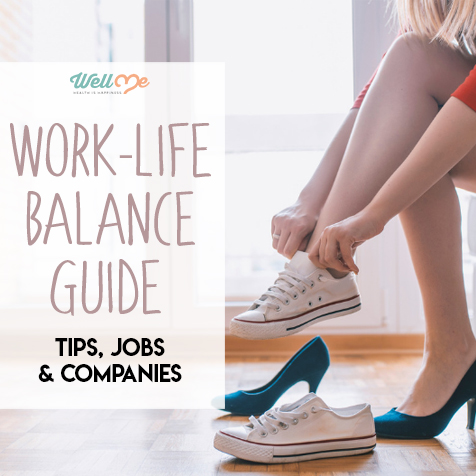Work-life balance seems like a pipe dream. How can one have a decent job, earn enough to pay all the bills, take care of the home and family, and still have “me-time”?
With advancements in technology, work all too easily invades our personal lives. Being constantly accessible with just a few clicks, we often never really leave work behind at the end of the day. We are in constant contact through our emails and messaging apps, and even leaving the office on time without guilt is challenging!
So how do we find work-life balance with today’s technology and modern career pressures?
From learning how to prioritize your time to finding the right jobs and employers, we have the tips and tricks to help you find your balance again. We’ll even shine a light on the jobs and companies said to have the best work-life balance.
Work-Life Balance Definition: What Exactly is Work-Life Balance?

Work-life balance is defined as: “A situation in which one divides or balances one’s time between work and activities outside of work”.[1] Focusing on one more than the other leads to an imbalance. Whilst work and careers are important parts of life, it is also important to prioritize your personal time to create a more balanced and healthier lifestyle.
On top of just balancing out work and personal time, we must also further categorize our personal time. Between running errands and social commitments, you need time that is truly your own. You need to plan your free time carefully so that you actually get “downtime”. That is part of what makes the balance work.
Relevant statistics about work-life balance
How many people have actually achieved work-life balance?
- 23.2% the general U.S. population are dissatisfied with their work-life balance, and 27.8% of the population has had at least one symptom of burnout.[2] 66% believe they do have a strong work-life balance.[3] 33% of employed adults works an average Saturday, Sunday or holiday.[4]
The fact of the matter is, many of us want it, and are even willing to trade-off other benefits to get it. 72% of Americans value work-life balance over salary and flexible schedules.[5]
Unfortunately, many companies are still catching up in terms of creating work environments that promote work-life balance and employee wellbeing. For instance, only 23% of companies in the finance sector feel that they are providing that balance to their employee.[6]
Fact: At least one in four people in the U.S. suffer from work-life imbalance.
The U.S. is ranked 30 on a list of 38 countries for work-life balance, behind the Netherlands, Sweden, and France.[7] The Netherlands limits the work week to four days or 29.2 hours per week. In Denmark, employees get to choose what time they start each day and whether they want to work from home. Employers in France encourage their employees to unplug during non-work hours.
While the U.S. may not yet stack up to its European counterparts, a growing number of companies are offering more work-life balance options such as:[8]
- Flextime
- Telecommuting
- Unlimited vacations
- Results-only work environments
- Work-flexible scheduling options that change as your situation changes
- Flex-locations
Causes of Work-Life Imbalance
Many things cause us to lose our sense of joy in our life’s balance. Below are a few of the major reasons.
1. Early-stage careers

Having young children at the same time as being low-seniority in your career can cause a lot of stress related to work-life balance.[9] The need to constantly prove ourselves at work and to maintain a healthy stable home where our children feel safe makes us feel like we are not achieving either.
2. Non-standard work schedules

When you’re working a non-standard work schedule, your daily rhythms might be a little topsy-turvy. Perhaps your job requires you to work weird shift hours. Or perhaps you have to work weekends instead of weekdays. So, while your family is enjoying breakfast together, you may be asleep in bed because you’ve been on the night shift. Your kids might have football matches on Saturday afternoons, but you can’t be there because you’ve got to be in the office.
When your life is on a different time schedule compared to your family, you tend to lose out on quality time with them. Studies show that non-standard work schedules often cause imbalance within a family on an emotional and practical level.[10] Apart from the time irregularities, non-standard work such as part-time jobs may present financial and career progression constraints, which could cause further stress and imbalance.
3. Lack of schedule control

If your work schedule is involuntary and you have no choice over the time or days you worked, this will only add to the imbalance of work-life demands.[11] This is true even if the work is part-time.
Interestingly, scheduling options do not provide a sense of work-life balance. Only scheduling control does that. Greater control leads to a greater sense of wellbeing, and those with high levels of wellbeing also perceive that they have greater control over their environment.[12]
While we may not be able to control our work hours or shifts, we can control the flow of our day while we’re at work, as well as in our personal lives. All it takes is a little bit of planning with some room in the schedule to yield to daily emergencies.
4. Personal and family characteristics

Men and women have different ideas about the appropriate amount of time to spend at work and for personal time.[13] Women tend to be more preoccupied with their time away from their families, in spite of working to give them more opportunities. Men’s historical role of being the main bread-winner lends them more control and balance, even if their situation is the same as a woman’s. This is because their traditional role required them to work to provide. This is the type of pressure that women still face after almost 80 years of building our own careers.
However, the main issue that causes the perception of an unbalanced work-life dynamic is children. Both single and married parents report less work-life balance in general.[14] Regardless of whether it’s in a single-earner two-parent household, dual-career parents, or single parents, they all exhibit the same perception of reduced work-life balance.[15]
5. Type of work

The type of work that easily leads to the feeling of imbalance are those that are difficult to separate from, whether emotionally or intellectually. There are certain professions that are more prone to workaholism.[16] Doctors, lawyers, CEOs, investors, and homemakers are among those who never seem to leave work behind! But teachers, community activists, and nurses also tend to be married to their careers, meaning that they find it hard to switch off from thoughts about work.
How Does it Disproportionately Affect Women?
Women tend to have less work-life balance than men.[17] Why is that? Below, we explore some key reasons why.
Motherhood

Women are expected to combine a career with motherhood.[18] One study noted that the interference of work into family impacted women’s perceptions more than men’s.[19] Specifically, it caused women to have significant issues with job satisfaction, subjective career achievement, and work pressure seeping into family time.[20]
Interestingly, another study found that women do not expect any assistance from their employers in their responsibilities to take care of their children.[21] This is because women feel that having children is a personal choice, and thus, feel obligated to opt out of their careers as the only option.[22] Meanwhile, men who take advantage of their employer’s offers for flextime or telecommuting feel that it helps them in their careers.[23] Ultimately, women feel less job satisfaction when work interferes with their home life, yet do not readily take up employer-offered benefits to enjoy more work-life balance.
Working Mothers

Work-family conflict is a dominant theme with women, as is our concern about our abilities to reconcile motherhood with career ambition. Women often do not feel able to achieve work-life balance that supports their careers. And it isn’t just our “perceptions.” Women in one study described being overlooked for promotions or professional development after taking time off to care for children.[24]
Meanwhile, men who have families feel more secure in their career paths when they partake of employer-offered benefits geared at helping them balance work and family.[25] They are comfortable turning down assignments and are not concerned that doing so would be detrimental to their career.[26]
Women with Alternative Schedules

Changing a full-time schedule to a part-time one after having children is also called the “mommy track” career path. In these cases, it does tend to provide a sense of work-life balance similar to that reported by men.[27] While that may mean less work commitments (which is great for more balance in life), it rarely offers women sufficient opportunity to rise higher in their careers.[28]
In the end, it means that when we want to advance into a stable and meaningful role at work while being a mom, we often have to look into further education or consider a different career path entirely.
Why is it Important to Achieve?
Working long hours impairs your health and increases stress.[29] This hurts our ability to enjoy our leisure time, both at work and at home. Thus, it is very important to find a better balance. Below is a list of benefits which highlight why work-life balance is important to achieve.

To manage stress better
Stress is associated with adverse effects on your immune system. It can also worsen any symptoms of medical conditions. Furthermore, it puts you at risk for substance abuse.[30] Stress causes anxiety about going to work, as well as leaving work. In turn, it reduces our ability to enjoy leisure time with our loved ones. Once you are able to achieve a better work-life balance, you can better manage stress and all its symptoms.
To spend more time on the things/people we love
Getting a grip on our complex lives will help us achieve what many of us aim for: more quality time with our family and friends. But don’t forget to include yourself in this equation! Avoid feelings of guilt for turning off your phone, or concerns that you will be bored if you take an afternoon for yourself. Get used to the idea that your workday ends at a certain hour and begin to live life outside of work.

For our identity
The difference between our “work-self” and our “true-self” may be in conflict when we are unbalanced. For example, being family-oriented but working long hours can be the cause of work-life imbalance.[31] Remember that identity is more than just the person you are away from your work environment. It involves feeding your ambition to complete personal projects and goals.
For our general wellbeing
Sometimes, it can result in dissatisfaction with life for too many pressures and not enough achievement. This is why it is so important to orient your day towards completing tasks, including those in your personal life. When we have a better overview of our lives and feel more in control, we are able to achieve our goals both at work and at home.
For health
When we are out-of-balance, the last thing on our list is to get regular exercise. However, taking good care of ourselves is actually one of the keys to manifesting a better work-life balance.[32] Whether it’s healthy food choices, deep breathing exercises, or squeezing in a workout, taking control of our health is one of the best ways to begin to attain it.
Work-Life Balance Tips

These work-life balance tips should help you find a good middle ground in your career and personal life.
General Tips For Achieving Work-Life Balance
- Make clear goals. Set goals for what you want to achieve in work, as well as in your personal life. List these in order of importance to you. Use these as your guide when you have to make decisions between work and life. It will help you decide where to spend your time. For example, if volunteering is a higher priority than your career, you’ll know to head to your local soup kitchen after work rather than doing overtime for that big promotion.
- Start small. Don’t make the change you want to see in one full-throttle move. Simply take a step in the right direction until you find a good balance. If you do all of the grocery shopping and prepare dinner every night, try getting meal prep delivery two nights per week to free up some time for you to relax (while still cooking fresh, healthy meals!).
- Make sleep a priority. Getting at least six hours of good sleep each night is vital to staying focused.[33] It minimizes distractions, helps you make better decisions, and supports you to remember things better.[34] Moreover, it also rejuvenates your body and mind to prevent burnout! It’s not always about finding the best work-life balance jobs, but finding the work-life balance within yourself.
How to Achieve Balance At Work

- Make to-do lists. It sounds obvious but keep “To-Do” lists and stay on task.
- Group small tasks. If you can, group small, similar tasks together to complete. For instance, checking and answering emails, or returning phone calls to different clients.
- Use a work timer. For those days when it seems like you can’t get anything done, use a timer at work. Set an alarm for one hour and try to do as much as you can. At the end of the hour, take a few minutes to regroup and reorganize the rest of the things on your to-do list. Then, repeat!
- Take breaks. Taking breaks during the day can prevent eye strain, body aches, and lowers stress by allowing decompression.[35]
- Have a chat. Chat with a friend or colleague who makes you laugh! Laughing increases oxygen to your brain and reduces levels of cortisol and adrenaline, which helps ease stress and tension.[36]
- Delegate. Don’t try to be a superhero! Share the load and delegate tasks whenever necessary and possible.
- Ask for help. Some companies offer programs to help their employees find greater stability. Talk to an HR representative to see whether they offer any perks such as on-site childcare, flextime or flex-location, telecommuting options, or other benefits you feel are necessary to achieve more work-life balance.
Fun Fact: One study noted that there are organizations who favor the occasional flexible work arrangement for individuals, instead of offering policies for the entire company.[37] So don’t be afraid to ask!
How to Achieve Balance at Home

- Turn your phone on silent. Stay present – do not constantly check your phone. Most messages can wait.
- Make a list of your priorities. Identify how you are maximizing your time to do them each day, week, or month.
- Schedule me-time. Doing something for just yourself for 20 minutes a day can make you feel so much better about your life. Get out on your own to enjoy something you love, or develop a new hobby that you will enjoy enough to continue doing.
- Meet friends once a month. Don’t hesitate to schedule that girls’ night out!
- Bullet journaling. These help you organize your entire year, and can help you identify your goals and determine the steps to take to reach them. Because it’s in a written format, you physically see and cross each item off your to-do list as you finish something, giving you a sense of accomplishment.
- Spend quality time with loved ones. Make sure to spend daily awake time with the ones you love, and your spouse or partner in particular.[38]
What Are the Best Jobs that Offer Work-Life Balance?
Sometimes achieving work-life balance requires us to take a hard look at our current lives. And this may mean looking for a new job or beginning another career altogether. When that happens, do your research to find a career or company with a culture that suits your needs.
The following lists contain the most viable careers and companies with the best work-life balance schedules for their employees. They may offer things like:
- More freedom in terms of work hours or locations
- More flexible work schedules
- Profit-sharing
- More paid time off
- The ability to move around in the company
- A shorter workday (e.g. 8.5 hours instead of 9)
- Job sharing
Continue reading to see if any of them offers you what you need from your career.
Best Careers for Work-Life Balance
Yes – there are certain careers that offer more of a balance than others. Here is our list of the best jobs for work-life balance, and all that comes with it.
1. Interpreter or Translator

- Choice of freelance/permanent roles
- Possible location and time-freedom
- Median salary: $44,000
- Unemployment: 4%
- Expected job openings: 17,500[39]
Being an interpreter or translator may require you to learn a new language. However, being able to communicate in a second, or even third language will open doors to many new opportunities. With freelance work, you’ll have the ability to control your schedule completely. Moreover, there are options for permanent roles in various agencies. This career pays well and even offers travel opportunities. It may also help to specialize in a certain industry to build industry-specific knowledge.
2. Dental Hygienist

- Flexible work schedule salary: $74,000 ($35.31 per hour)
- Unemployment: 1.2%
- Expected job openings: 37,400[40]
This job involves cleaning patients’ teeth, examining for signs of oral disease, and providing preventative dental care. In order to pursue this career path, you will be required to have an Associate’s degree. Currently, more than half of the dental hygienists work part-time.[41]
3. Web Developer

- Choice of freelance/permanent roles
- Possible location and time-freedom
- Median salary: $65,000
- Unemployment: 3.6%
- Expected job openings: 39,500[42]
In this position, you would need to create web pages or design software, write code, and check for bugs. Being a web developer allows for a lot of freedom and control over your work schedule. Additionally, this job can be done from anywhere in the world! However, if you’re looking for something with a base, there are also positions in agencies or companies’ in-house teams.
Companies with the Best Work-Life Balance
More companies are getting on board with what used to be a joke about millennials: more money for less work and less time spent in the office. Although it seems like a far-off ideal, some startups are quickly ascending in popularity due to a novel idea and a great work-life balance.
Lyft

This is a relatively new international company that provides a platform for people to use their own cars to transport people from place-to-place. As a driver, you can work anywhere, anytime, as much or as little as you like. Lyft also has salaried and hourly employee statuses at their offices in major cities worldwide.
- Salaried employees have unlimited paid vacation.[43]
- Full-time hourly employees have 15 days of paid vacation, 5 sick days, and 10 paid holidays per year.
- They offer health insurance options and 401(k) savings packages too.

While tech companies are often known for their outrageously good perks, Google provides a few interesting ones that help their employees relax and enjoy coming to work. They also establish a comfort level for employees to take advantage of these benefits. Here are just a few of them:
- An on-site gourmet chef cooks employees free breakfast and lunch every day. On top of that, fresh fruit and snacks are available throughout the day. Thanks to this perk, employees don’t need to spend an personal time preparing healthy meals and snacks during their work day.
- Free fitness classes and gym equipment are provided for employees. This encourages them to stay healthy without added personal expense.
- A very generous paid vacation schedule of 15 days for first-year employees, with this increasing to 25 days after five years.
- Flexible working hours.
- Google allows dogs at work, so you don’t have to pay for a dog-walker or a doggy daycare.
- 18 weeks of paid maternity leave and free on-site daycare.[44]
Hyatt Hotels Corporation

The Hyatt seems to really care about its employees and their work-life balance. Their perks include provisions while at work, as well as very generous applications of flex and vacation time. Additionally, it offers traditional benefits packages to help plan for your future.
- Eight weeks paid family leave
- Four weeks of paid vacation time after one year for full-time employees
- Five days of paid vacation time after one year for part-time employees
- 100% matching contributions to IRA up to 3%
- Free on-site dry cleaning
- Flexible housekeeping schedule – begin and end your shift when it’s convenient
- Free meals for all shifts
- Free hotel stays
Work-Life Balance Quotes to Inspire You
Getting a grip on our work-life balance is easier said than done. It requires time, focus and patience. In the interim, read these mini-inspirations to help you see you are not alone!
- “You actually don’t have to do it all.” – Danielle LaPorte
- “Always take some of the play, fun, freedom, and wonder of the weekend into your week and your work.” – Rasheed Ogunlaru
- “You will never find time for anything. If you want time, you must make it.” – Charles Buxton
- “For fast-acting relief, try slowing down.” – Lily Tomlin
- “We must always change, renew, rejuvenate ourselves; otherwise we harden.” – Johann Wolfgang van Goethe
- “Balance, peace, and joy are the fruit of a successful life. It starts with recognizing your talents and finding ways to serve others by using them.” – Thomas Kinkade

Conclusion
Trying to bring balance back into your work and home life doesn’t have to be unattainable. However, it does take some work. Add it to the top of your to-do list and start making it happen by using all of our expert tips and tools. Just take a few deep breaths and dive straight in!
References
- [1] https://www.dictionary.com/browse/work-life-balance
- [2] https://www.ncbi.nlm.nih.gov/pmc/articles/PMC4705299/
- [3] https://familylivingtoday.com/work-life-balance-modern-era/
- [4] https://familylivingtoday.com/work-life-balance-modern-era
- [5] http://workplace.care.com/the-most-compelling-work-life-stats-of-2017-so-far
- [6] http://workplace.care.com/the-most-compelling-work-life-stats-of-2017-so-far
- [7] https://familylivingtoday.com/work-life-balance-modern-era/
- [8] https://www.fastcompany.com/3058344/5-flexible-work-strategies-and-the-companies-who-use-them
- [9] https://www.ncbi.nlm.nih.gov/pmc/articles/PMC4705299/
- [10] http://www3.uakron.edu/publications/tausigunbindingtime.pdf
- [11] http://www3.uakron.edu/publications/tausigunbindingtime.pdf
- [12] http://www3.uakron.edu/publications/tausigunbindingtime.pdf
- [13] http://www3.uakron.edu/publications/tausigunbindingtime.pdf
- [14] http://www3.uakron.edu/publications/tausigunbindingtime.pdf
- [15] http://www3.uakron.edu/publications/tausigunbindingtime.pdf
- [16] https://www.businessinsider.com/highest-paying-jobs-for-workaholics-2016-9#-13
- [17] http://www3.uakron.edu/publications/tausigunbindingtime.pdf
- [18] https://www.ncbi.nlm.nih.gov/pmc/articles/PMC3122548/
- [19] https://www.jstor.org/stable/20832044?&seq=1
- [20] https://www.jstor.org/stable/20832044?&seq=1
- [21] https://www.gendereconomy.org/the-damaging-effect-of-gendered-views-of-work-life-balance/
- [22] https://www.gendereconomy.org/the-damaging-effect-of-gendered-views-of-work-life-balance/
- [23] https://www.gendereconomy.org/the-damaging-effect-of-gendered-views-of-work-life-balance/
- [24] https://www.gendereconomy.org/the-damaging-effect-of-gendered-views-of-work-life-balance/
- [25] https://www.gendereconomy.org/the-damaging-effect-of-gendered-views-of-work-life-balance/
- [26] https://www.gendereconomy.org/the-damaging-effect-of-gendered-views-of-work-life-balance/
- [27] http://www3.uakron.edu/publications/tausigunbindingtime.pdf
- [28] http://www3.uakron.edu/publications/tausigunbindingtime.pdf
- [29] http://www.oecdbetterlifeindex.org/topics/work-life-balance/
- [30] https://www.mayoclinic.org/healthy-lifestyle/adult-health/in-depth/work-life-balance/art-20048134
- [31] https://asu.pure.elsevier.com/en/publications/becoming-a-character-for-commerce-emotion-labor-self-subordinatio
- [32] https://www.mayoclinic.org/healthy-lifestyle/adult-health/in-depth/work-life-balance/art-20048134
- [33] https://www.sleep.org/articles/sleep-and-productivity-at-work/
- [34] https://www.sleep.org/articles/sleep-and-productivity-at-work/
- [35] https://www.incorporatemassage.com/blog/benefits-of-taking-breaks-at-work
- [36] https://www.organicfacts.net/health-benefits/other/health-benefits-of-laughter.html
- [37] https://www.gendereconomy.org/the-damaging-effect-of-gendered-views-of-work-life-balance/
- [38] https://www.ncbi.nlm.nih.gov/pmc/articles/PMC4705299/
- [39] https://money.usnews.com/careers/slideshows/14-best-jobs-for-work-life-balance?slide=13
- [40] https://money.usnews.com/careers/slideshows/14-best-jobs-for-work-life-balance?slide=14
- [41] https://www.bls.gov/ooh/healthcare/dental-hygienists.htm
- [42] https://money.usnews.com/careers/slideshows/14-best-jobs-for-work-life-balance?slide=14
- [43] https://www.lyft.com/careers/life-at-lyft
- [44] https://www.inc.com/business-insider/best-google-benefits.html








